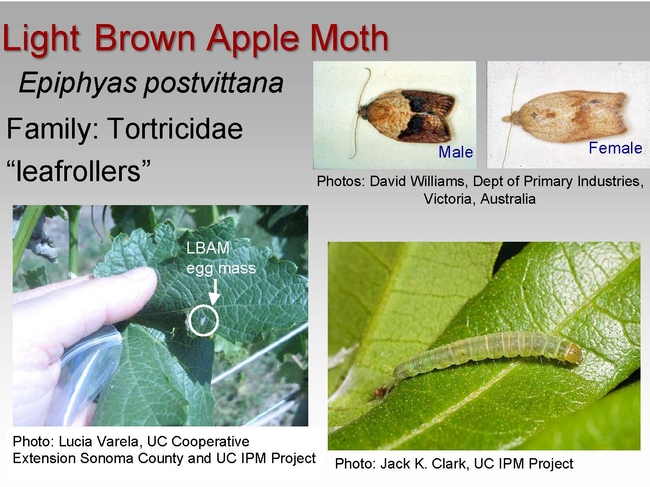Light Brown Apple Moth
By Andrea Peck
The news is full of bug sightings. Perhaps they are taking a summer vacation or perhaps we're getting better at trapping them. I've spotted my own – but I'll talk about that next week. Mine are bigger, furrier and accessorized with tails. The memories are still too painful and fresh. No, this week we will have to resign ourselves to a few small but devastating wranglers that seem to be on a roll here in San Luis Obispo County. I'm not going to talk about the single Asian citrus psyllid which was discovered cooling its heels in Cayucos recently (look to last week's post for information on that pest). This week I set my sights on a certain party of three light brown apple moths (Epiphyas postvittana) who were found and busted in Arroyo Grande.
The light brown apple moth (LBAM) is a humble creature that is native to Australia. Despite its unimpressive appearance, this beast feeds on a wide range of plant species. During its caterpillar stage, it eats everything. Maybe it's myopic. Maybe it's just confused. These are possibilities. But, remember, this bugger is from Australia, where the men are brawny and the bugs are opportunists. It's like the goat that started chewing on my green dress when I visited the zoo as a child. You might question its proclivities, but the reactive among us don't ask why, we just run.
The LBAM is a stealth rapscallion that varies in appearance and is difficult to identify. In fact, the only sure way to know that you have an LBAM is by inspecting its reproductive organs. In Australia the moth is considered a major pest of apples, oranges, pears and grapes. The term ‘apple moth' is deceptive, however. They prey on apples, but are polyphagous, meaning they dine on a wide variety of crops, plants and ornamentals. The LBAM prefers cooler climates with low rainfall and high humidity. Hot environments lower their survival rates and quell breeding. The LBAM is part of the leafroller family (Tortricidae). This family is distinguished by its ability to roll a leaf, sleeping-bag style, around its larvae, secure it with webbing, and then eat the leaf without leaving its cozy confines.
White or light green eggs are laid by adult moths and are typically found in masses of 20 to 50, but up to 170 eggs in a mass have been found. Eggs appear shingle-like or similar to the scales of a fish.
The caterpillar is medium green in color with whitish appearing hairs. The head is a yellow-brown. It is this stage of growth that the LBAM is most damaging.
Baciillus thuringiensis kurstaki (Bt) is one method of control. Others include: spinosad (Entrust and Success), spinetoram (Radiant), methoxyfenozide (Intrepid), tebufenozide (Confirm). Some organophosphates, pyrethroids and carbamates are reported to control LBAM. Pheromone mating disruption may be successful with chronic problems. Where some damage can be tolerated, biological control, such as parasitoids may lower populations.
Currently there is a 9-mile quarantine area surrounding the homing location of the detected moths in Arroyo Grande. Management efforts continue extensively throughout the state.
